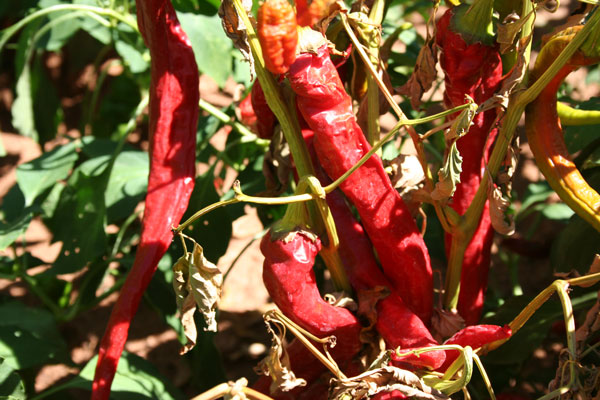
With the advent of cooler weather and the biological changes in pepper plants as a result, green pepper harvest is winding down now and harvesting red peppers now takes over as the primary task at hand, with early reports indicating there are still plenty of red peppers being picked and dried and sold at roadside stands and grocery stores across the Southwest.

While most green chili pepper growers in southern New Mexico say it has been a good year for their famously spicy crop, others say they suffered from heavy rains and even a few hail storms late in the season that slowed harvest and in some cases damaged their crop and slowed harvest in the fields.
But with the advent of cooler weather and the biological changes in pepper plants as a result, green pepper harvest is winding down now and harvesting red peppers now takes over as the primary task at hand, with early reports indicating there are still plenty of red peppers being picked and dried and sold at roadside stands and grocery stores across the Southwest.
In chili-rich Doña Ana County, the mega-center of chili pepper production in a state famous for chili peppers, this year's crop has been somewhat of a mixed bag.
Salem farmer Jerry Franzoy reports the harvest season started off in August under prime conditions, but with the advent September, heavy rains forced harvesters out of the fields and some plants were damaged as a result of the weather. The set back wasn't great however and resulted in a loss of "less than five percent under early harvest expectations."
But Franzoy says in spite of the heavy rains that diminished production slightly around Hatch, chili peppers fields around the Las Uvas Valley area produced peppers of excellent quality.
If you are enjoying reading this article, please check out Southwest Farm Press Daily and receive the latest news right to your inbox.
Chris Biad, whose family grow chilis and operate a processing plant that handles chili peppers purchased from multiple growers, says he started the season with a lot of unanswered questions. For one, a shortage of irrigation water from the Rio Grande river was a major concern. Diminishing flows caused by consecutive years of extreme drought limited irrigation water for all of southern New Mexico, and Biad said growers had to resort to pumping groundwater from over-taxed wells.
"It increased our production costs considerably and we prefer to have the sweet water of the river as it plays an important role in our chile in terms of both quality and taste. But most every grower is reporting a good crop this year with good to excellent quality, and demand remains high," Biad said.
Seasonal rains were good or bad, depending on location
While late season rains caused setbacks for some growers, others say the underlying result may have actually helped to increase the quality of late season chili peppers depending on the amount of rain received in any given area.
A drive down roads that cross concentrated chili pepper production areas provides evidence that red chili season is well underway now. In addition to workers in the fields pulling peppers from plants there are obvious signs of chili drying, in some cases on rooftops where the product dries under the warm New Mexican sun as workers rake through the peppers to provide even drying.
Where green chili peppers were roasted in the parking lots of grocery stores and roadside stands attracting large and eager crowds across the Southwest in recent weeks, red chili production has extended the demand for product for the traditional making of colorful ristras, or strands of red chili peppers so popular across the state. Popular for their decorative value, the ristras also provide a perfectly dried pepper over time and is then ground into chili powder than can be used long after the season is over.
Though fields have largely turned red instead of green this late in the harvest season, growers say there are still green chili peppers being harvested as well and this provides for what New Mexicans call a "blended season," or as one grower put it, "the best of both worlds."
The demand for fresh green chile remains strong until they are all gone, then the red chile season kicks in and there is another rush to gather the chiles to sustain the benefits and meet the demands of what many call the state's favorite food product.
"We are also processing roasted green chili and packaging it up for use over the holidays and later throughout the year as well as producing dry red chili powder through our processing facility that will continue to supply the demand for New Mexico chile throughout the year," Biad said.
While weather, lack of water, disease pressure and labor issues continue to plague a time-honored New Mexico industry, chili pepper growers and processors say this year, in spite of a few setbacks, has been a positive year in terms of supply and demand. Declining profits and escalating input costs may be a major concern, but when late summer and fall arrives, even chili growers and processors say they depend on fresh green and red chili to make the year complete - and tasty.
More from Southwest Farm Press:
New Mexico and Texas specialty crop grants
Farm workers needed to sustain heritage crop
Hatch chili harvest underway in New Mexico
About the Author(s)
You May Also Like



